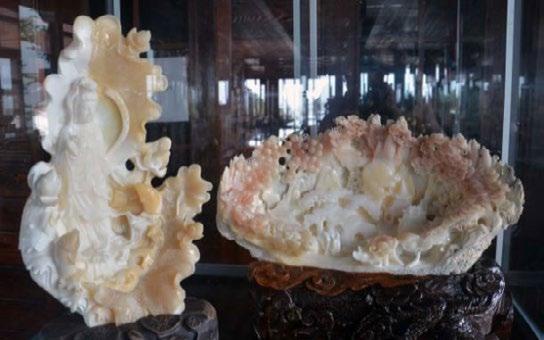
3 minute read
Convergence with other wildlife products
The reported seizures in China indicate a high rate of convergence of giant clam smuggling and trade alongside other wildlife species, with almost half of the seizures (22 cases) involving parts or products from multiple species.
Of particular concern are eight seizures (17% of all cases) that involved carved clam shell products with carved elephant ivory and other types of ivory or ivory-like products, including mammoth ivory, narwhal ivory, and unspecified “whale tooth”. Two of these cases also involved rhino horn products and helmeted hornbill casques. The convergence observed in these eight cases suggests that the same criminal groups are involved in the illegal trade of both commodity types in China. It is not clear from these cases whether the convergence could indicate that the market for other ivory-type products could potentially be used as a cover to launder elephant ivory products in China, or whether the market preference could be shifting to ivory substitute materials due to the strict enforcement of the ivory trade ban, but this hypothesis is further discussed in the section on ‘China’s elephant ivory trade ban and the use of substitute materials.’ Six of the eight seizures occurred after China introduced the ban, which could indicate these cases may have been detected as part of China’s efforts to crack down on ivory trade. It is also noteworthy that two of the cases involved sourcing giant clam shell and elephant ivory products from Japan, which has a legal domestic ivory market, and then smuggling them into China for illegal trade. These two cases are further described in the section below on ‘Japan as a potential location of concern’.
Advertisement
Image 15: Giant clam shells carved into an array of ornaments and jewellery, including imitation elephant ivory tusks – Tanmen, August 2016 Credit: Mei Lin Neo.

Image 16: The most frequent convergence observed in the seizures was giant clam shells with other marine products, such as dried seahorses. Credit: A. K. Y. Wan.
The most frequent convergence in the seizures was of giant clam shells with other marine products, particularly hawksbill turtle shell crafts (12 instances), corals (five instances), seahorses (two instances), and other seashells (nautilus, conch, Cassis cornuta, etc.). In one notable case involving seahorses, two Chinese subjects travelled from Guangdong province to the China-Vietnam border in Guangxi Zhuang Autonomous Region to arrange the delivery of a shipment of thousands of dried seahorses and seadragons from the owner of the “Vietnam Drunken Beauty Specialty Store” (越南醉美特产店). The products were allegedly smuggled from Vietnam to China via an unofficial border crossing, and in March 2019 transported via SF Express courier service to addresses in Guangdong and Anhui provinces. Law enforcement raids at these addresses resulted in the arrest of three suspects and the seizure of a total of 44,691 dried seahorses (87.15 kg) and 1,815 dried sea-dragons (11.8 kg), along with giant clams, other shells, and suspected sea catfish. All three suspects were convicted in June 2020 and issued with penalties of 10 years imprisonment and confiscation of RMB 1 million (USD 154,237), six years imprisonment and RMB 300,000 fine (USD 46,271), and 3.5 years imprisonment and RMB 150,000 fine (USD 23,135).40
The convergence is of interest in this case, as two countries that are known to be major sources in the illegal seahorse trade - Vietnam and the Philippines41 - also have suspected links to China for giant clam smuggling. Along with the various other cases involving hawksbill turtle products, corals, and other seashells, this could point to a potential convergence in the supply chain for marine products, such as source locations and/or smuggling routes. This hypothesis aligns with findings from the Wildlife Justice Commission’s own investigations, which have identified many wildlife trafficking networks dealing in a multitude of species that converge at common nodes such as key facilitators and smuggling points.










